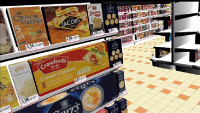CATEGORY MANAGEMENT
SECTION ONE
SECTION TWO
Debunking Four Myths About
Virtual Shopping Research
While virtual shopping research is still developing, there are several
concepts that are misunderstood.
“Manufacturers have embraced virtual shopping and retailers have accepted the results. Companies have taken it to the next level. Virtual shopping is everything from going over adjacencies to category reinventions, to — from a brand perspective — figuring out how inputs such as variations in cost of goods are affecting the size of a package, the price of a package, and how that is all going to play out on the shelf,” says Rich Rizzo, vice president, consumer insights, Vision Critical.
Virtual shopping tests essentially involve consumers evaluating products on computerized shelf sets. It has evolved from central locations to online platforms and from super computers to notebooks, with increasing accuracy in real world validation. The technology has also moved from flat two-dimensional images to three-dimensional modeling. Along the way, it has become an integral category management tool.
Rizzo lists four myths about the current state of the art in virtual shopping research:
- 3D is superior to 2D
- Monadic is superior to sequential monadic
- Reduced shelf is no substitute for full category
- There is no substitute for traditional eye tracking.
In practical applications of virtual shopping, test results from 3D images are similar to results from 2D images. The difference between 3D and 2D is the viewer’s perspective. While 3D seems more realistic and shoppers will spend more time with it, there is little additional value gained for the significant expense it requires. Basket sizes are not materially different, and unless a manufacturer is concerned about package changes or a situation where they want people to pick up and buy more products, 2D is adequate, while saving time, money and effort.
Some in the industry debate the relative benefits of monadic, where the viewing consumer is presented with one product at a time, and sequential monadic, where more than one product is involved, although they are examined separately. In studying this, Vision Critical found there to be little difference. Consumers involved in the testing still bought comparatively the same amount of product.
In tests of whether a reduced shelf is no substitute for full category — a frequent question because of missing images from categories — there were no significant differences in shopping behaviors. For example, in a shelf set involving 200 SKUs, there are usually about 10 or so images that can’t be located, and the test has to be run without them. This makes little difference in the results, according to Rizzo.
Another topic of frequent debate is whether there is a good substitute for traditional eye tracking. Vision Critical did tests of three products from different categories involving eye tracking and central location eye tracking technology. In every case, the results came back exactly the same as far as the intensity of looks given to the items.
For the future, Vision Critical has developed a technology it calls, “Build Your Own Aisle.” This allows brand personnel, retailers, and consumers to create their own category sets. In one test, a consumer-designed planogram won out over those designed by the brand and retailer personnel, and is now being further tested at retail.
Discrete choice modeling can be used when manufacturers encounter rising costs and have to consider either a smaller package at the same price, or raising the price on the current package, which happens frequently. This also helps evaluate what to do when it comes to SKU and line optimization.
Virtual in-home usage tests bring real-world insights into consumer behavior after they actually taste a new product. This begins with a virtual shopping test, but then the product is shipped to consumers. Once manufacturers see the results, they are more comfortable about bringing a product to market. This can also help determine pricing. They often know what the floor threshold price would be. Once people taste the product, however, the manufacturer knows more about how high they can go in pricing.
Mobility is a very hot topic with CPG manufacturers now, and mobile virtual shopping technology is getting started. These tests can take advantage of the real-time and location-based attributes of mobile devices, and are especially crucial in connecting with younger demographics. The surveys are automatically formatted for the device being used, whether a desktop/laptop, smartphone or tablet.
Augmented reality is a live, direct or indirect, view of a physical, real-world environment whose elements are augmented by computer-generated sensory input such as sound, video, graphics or GPS data. Vision Critical is developing ways this can be used for virtual shopping research.
Summing up, Rizzo says: “Consumers now have a bigger voice than ever, and that includes the research. Brands don’t know everything and retailers don’t know everything. They need to take this research into account from the shopper perspective, which they are doing in all other disciplines as well.”
This article was abstracted from a presentation by Rich Rizzo, vice president, consumer insights at Vision Critical, at the recent LEAD Marketing Conference in Chicago. More information about Vision Critical can be found at www.visioncritical.com.
Click on the LinkedIn logo to join the new Shopper Technology Institute Discussion Group
SECTION THREE

